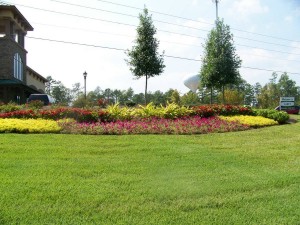|
Gardens Ablaze |
||
|
|
Cool Season
Grasses
|
|
|
Site Map
Home
|
If you are one that is satisfied with a beige lawn, the only care required during the fall and winter is to be on the lookout for weeds such as wild onion, violets, etc. Pull these weeds as soon as you spot them, using a weeding tool if necessary. Mow the grass a little higher during the fall (about 1 inch higher than usual), because warm season grasses use the cooler fall weather to build up reserves to survive the harsh winter. Mowing too low this time of year can kill it altogether. For those who want a green lawn during the cold months, there are grasses that do very well in all but the harshest winter areas. If you have an established warm weather lawn, it can be overseeded with a cool weather type of grass that will stay green through most of the cold weather. Types of grass that can be used include ryegrass, bluegrass and fescues. Ryegrasses include Annual Ryegrass and Perennial Ryegrass. Both germinate rapidly (but annual is faster), and are clump-forming rather than spreading types of grasses. Perennial ryegrass is the preferred type because of it's glossy, attractive, deep green appearance. However, annual ryegrass is less expensive, germinates more rapidly, and also has an attractive appearance, though both should be used only in the more temperate regions, as they are both somewhat sensitive to extreme temperatures. Bluegrasses are fairly tough and cold tolerant, and the familiar Kentucky bluegrass is undoubtedly the most popular type. It has a beautiful appearance, and is the grass used most often on golf fairways and athletic fields because of it's attractiveness. It does best in the colder regions and higher elevations. The down side of using bluegrass is that it requires fairly heavy watering and fertilizer to keep it at it's peak. Fescues include Red Fescue and Tall Fescue. Red fescue is a tough grass that does well in shade and drought. It has an attractive appearance, with fine, dark green blades. It does not like extreme heat, however, so if used as a permanent lawn, it should be sown where the summers are somewhat cool, such as in the Midwest. It can also be used as a lush meadow grass in areas that are too steep to mow. Tall fescue tolerates drought, shade, and heat better than any of the other cool season grasses, but is not the most attractive of the lot. It has a clumping habit, and is a course turf grass, but it will stay green all year in the milder areas, and makes a good all-purpose lawn.
To
overseed your warm weather lawn for a lush green look during the cold months,
make sure you buy seed that is specifically meant for overseeding, regardless
of the type of grass you choose. About a month before the first hard
freeze, mow your lawn slightly lower than normal, and rake thoroughly.
Using a hand spreader, spread your chosen seed at a rate of 5 to 10 pounds
per 1,000 square feet. Walk the lawn back and forth in it's entirety
spreading about half the seed, then repeat, walking the lawn from the other
direction to ensure even seed distribution. Water as needed until
you see sprouts forming, and then make sure that the soil doesn't become
completely dry. Mow when the grass reaches around 3 inches.
Plant some pansies or other cold tolerant border plants along the flower
borders, and your yard will be the talk of the neighborhood this winter!
Custom Search
|
|
|
Gardens Ablaze |
||
 The
lawn is one of the most important aspects of most home landscapes, and most
of us put a lot of time and effort into the care and maintenance of our
lawn turf. With the fall season upon us, we are now facing dormancy
of our lawns, and the prospect of a beige or brown carpet surrounding our
houses for many months to come. Beige is okay, and if the lawn is
properly maintained, raked, and edged, it is not unattractive, though it
doesn't compare to the bright green lush carpet of summer.
The
lawn is one of the most important aspects of most home landscapes, and most
of us put a lot of time and effort into the care and maintenance of our
lawn turf. With the fall season upon us, we are now facing dormancy
of our lawns, and the prospect of a beige or brown carpet surrounding our
houses for many months to come. Beige is okay, and if the lawn is
properly maintained, raked, and edged, it is not unattractive, though it
doesn't compare to the bright green lush carpet of summer.